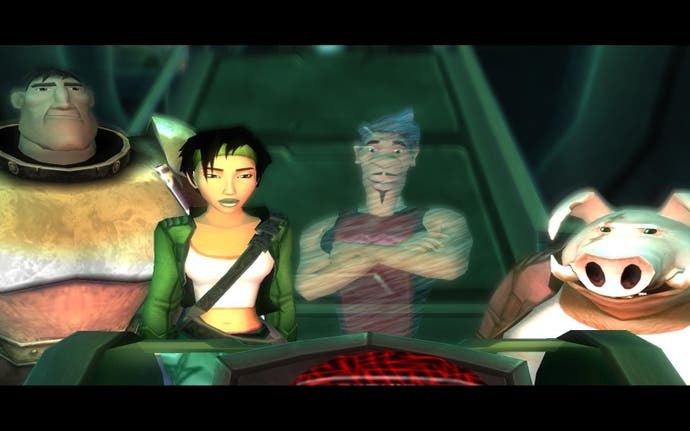Retrospective: Beyond Good & Evil
Photograph-'em-up.
Thank goodness, yes it is. There's a horrible tension when you return to a game that's entered legend. What if it was hype? What if things have moved on so far that it creaks and you feel silly trying to play it? Worst of all, what if you've been desperately hoping for an oft-suggested sequel, getting excited at the prospect of its existence, and then you discover the original wasn't what you remembered? Thank goodness, Beyond Good & Evil is still every bit as wonderful.
Hillys, a planet under siege by an alien enemy known as the DomZ, is the home of Jade, a photographic journalist and foster parent to the area's increasing population of orphans. It's an odd place, where various anthropomorphised species co-exist in a city made up of a collection of islands. Frequent attacks from the DomZ mean life is constantly interrupted with bombardments from horrendous beasts, while many citizens are kidnapped, and never heard of again.
Jade, on her private island, in her lighthouse home, is immediately one of gaming's most completely lovely people. Not only is she the most modestly attractive videogame character ever to have stolen our hearts, but she dedicates all her spare time to raising orphans. Living with her "uncle", Pey'j, a pig-like creature who helps Jade raise the kids as well as working on mechanical projects in his workshop, times are tough. The electricity is cut off due to late payment right as an attack arrives, leaving them without a shield. This leads to the kidnapping DomZ beasts trapping a number of Jade's adopted children. These alien foes get seven shades of crap pummelled out of them as you're introduced to Jade's dai-jo staff-based combat.

Needing money, Jade picks up work cataloguing Hillys' flora and fauna for a database. Which means as the game begins, your first post-fight task is to walk around your island, taking photographs.
It's a remarkably gentle introduction, letting you explore all the nooks and crannies of the lighthouse and surrounding area. You quickly get used to using the camera, snapping pictures of the various species of children living with you, your pet dog, and the wild creatures that live nearby. With enough on film, you receive your first payment, and get the electricity back on. It's so mundane, so calm, that it's hard to imagine any game daring to open this way. But it sets a mood that's essential to understanding everything that's going to follow. Jade is a calm, practical person, thrown into remarkable circumstances. She's not an action hero, and isn't going to become one.
What struck me most, returning to this after many years, was quite how unlike anything else the game was. There are comparisons to be drawn, certainly. The gorgeous chunky cartoon world (still adorable after over five years, thanks in part to smart design in the first place, and partly due to the PC version happily scaling to enormous resolutions) and third-person action are in some ways traditional, recalling Ratchet & Clank. That mixture of relaxed exploration punctuated by frantic action. However, this is a whole other kind of relaxed.

The story's broken up into four distinct chapters: the early exploration and discovery of the city, The Factory, the Slaughterhouse, and finally the Moon. However, between each you're left to your own devices in a remarkably unhurried fashion. I'm so sick of games telling me I can choose what I want to do, while screaming in my ear that I need to be hurrying somewhere else. While perhaps Jade has good reasons for pressing on as the plot progresses, the game doesn't fuss at you if you want to compete in one of the hovercraft races, or chase pirates, or hunt in caves for pearls, or just go and have a chat with the kids milling around the lighthouse or sunbathing on the cliffs. Maybe play a game with a shark in the bar (a shark, geddit?!). Or, most of all, using a scanner you've purchased, go on the hunt for other species you haven't photographed yet. There's a marvellous story to play through, and the game's distinctly different styles appear in those narrative sections, but BG&E isn't hurrying you. It's a quiet, gentle game, and it wants you to feel that, to relax into it.
Hillys is apparently being protected by a military force called The Alpha Section. Their constant, omnipresent messages on TV, radio and floating video screens, assure citizens that without them the DomZ would kill them all, and how grateful they should be to their Alpha Section overlords. Unsurprisingly, this is less than truthful. Jade soon discovers an underground movement of rebels called The IRIS Network, who are plotting against the Alpha Section, who they maintain are in league with the DomZ. Joining IRIS, Jade's photojournalistic skills are put to good use, as she's sent into the Alpha Section areas to photograph illicit activity and send it back to IRIS, who then publish it in their underground literature aimed at undermining the authorities.

